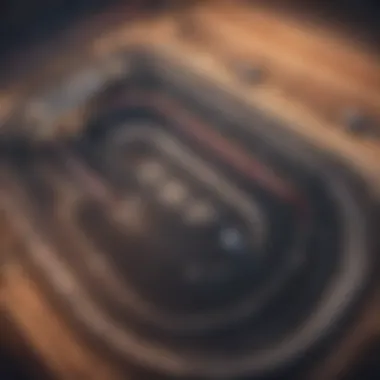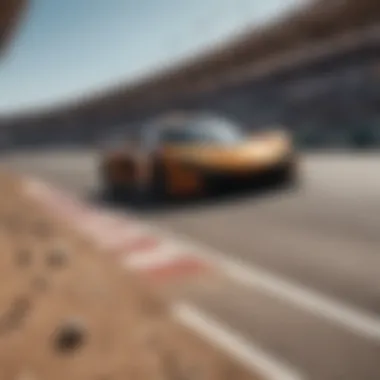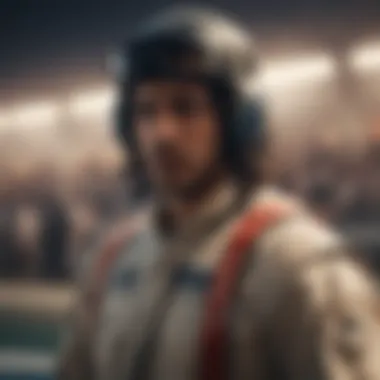Exploring the Significance of the Saudi Grand Prix 2021


Intro
The Saudi Grand Prix 2021 marked a pivotal event in the realm of Formula 1, showcasing not just the exhilarating dynamics of motorsport but also the socio-political context of the host nation, Saudi Arabia. As the season’s penultimate race, it garnered attention worldwide, bringing forward discussions related to track design and cultural implications. This article delves into various aspects of the Grand Prix, examining its significance from multiple perspectives, including performance metrics, environmental factors, and its broader influence on motorsport. The examination aims to provide an insightful understanding about why this race was not just another event on the calendar, but rather a culmination of intricate narratives within the world of Formula 1.
Techniques and Tips
Skill Development
To appreciate the intricacies of the Saudi Grand Prix, one must recognize the critical skills involved in racing, particularly in navigating a complex track layout. Drivers specialize in multiple skills, such as cornering precision, throttle control, and managing tire wear under high-speed conditions. Advanced simulators play a key role in replicating track environments allowing drivers to practice before entering the competition.
Practical Techniques
Understanding the limits of the car and how to exploit them is essential. Here are a few practical techniques that drivers often deploy:
- Late braking: Maximizing braking efficiency in corners.
- Apex strategy: Finding the optimal point of corner entry and exit.
- Throttle modulation: Adjusting throttle input during cornering enhances overall speed and stability.
Common Mistakes to Avoid
New drivers and even seasoned professionals can fall into several traps:
- Overdriving corners: This leads to loss of speed.
- Ignoring track conditions: Adapting to changing weather or track surface is crucial.
- Poor tire management: Misjudging tire wear can affect lap times and overall performance.
Gear and Equipment
Essential Gear for Beginners
Entry-level racers must equip themselves adequately to ensure safety and performance. Essential gear includes:
- Racing helmet: Certifications from organizations like the FIA ensure safety standards.
- Racing suit: Fire-resistant suits protect drivers during incidents.
- Gloves and shoes: Provide grip and protect the driver.
Latest Innovations and Trends
The racing world is continuously evolving. Technologies now influence car design and driver performance. The integration of telemetry and data analytics helps teams to analyze performance metrics in real-time, enhancing decision-making processes during races.
Reviews and Comparisons
When considering gear, it is crucial to analyze different brands and their offerings. For instance, comparing the safety features of Bell helmets against Arai can help novice racers select suitable equipment for their needs.
Safety Measures
Essential Safety Gear
The safety of participants in extreme motorsport events cannot be overstated. Fundamental safety gear includes:
- HANS device: Prevents head and neck injuries.
- Fire retardant materials: Used in suits, gloves, and shoes.
Best Practices for Safe Participation
Practicing safe driving behaviors can significantly reduce risks during a race. Keeping a clean racing line, maintaining awareness of other drivers, and using mirrors effectively are critical in high-speed environments.
Injury Prevention and Management
Even with all precautions, injuries can happen. Teams must have protocols for effective response, including:


- Prompt medical evaluation of drivers.
- Established protocols for dealing with on-track incidents.
Finale
The Saudi Grand Prix 2021 stands as a testament to the evolving landscape of Formula 1, blending speed, culture, and caution into a singular event that captured global attention. The analysis of this race sheds light not only on the driving techniques and safety measures crucial for participants, but also on the broader implications of hosting such an event in the current backdrop of global motorsports. By examining both performance and cultural contexts, it becomes clear how intricate and multifaceted the stories surrounding this race truly are. Through this detailed investigation, one can appreciate how the Saudi Grand Prix is emblematic of the future of racing in more diverse regions.
Overview of the Saudi Grand Prix
The Saudi Grand Prix, hosted for the first time in December 2021, marked a significant milestone in Formula 1's calendar. This event not only introduced a new and unique race to the championship but also showcased Saudi Arabia's increasing involvement in global motorsport. The race was notable for its night setting, illuminating the Jeddah Corniche Circuit against the backdrop of the Red Sea. This distinctive aspect added complexity and visual appeal to the event, enhancing its global allure.
Historical Context
The Saudi Grand Prix's inception can be traced to the Kingdom's broader vision of transforming its economy and fostering tourism through high-profile sporting events. The advent of this race reflected a focused strategy to embrace motorsports, contributing to Saudi Arabia's goal of enhanced international presence. Moreover, the event was influenced by the rapid development of other races within the region, including the Bahrain Grand Prix. These races established a competitive landscape for Formula 1 in the Middle East, leading to Saudi Arabia's investment in the sport.
Since its official announcement, the race sparked discussions regarding its timing and significance in a rapidly evolving landscape of motorsport. The deployment of the Jeddah circuit, characterized by its challenging layout and high-speed sections, was an engineering achievement in itself, which took advantage of the coastal environment.
Significance in the F1 Calendar
The Saudi Grand Prix represents a key addition to the Formula 1 calendar. It provided another layer of global diversity to the series, expanding its reach beyond traditional markets. The race was immediately positioned as a night event, enhancing both visibility and audience engagement across different time zones. Consequently, this innovative timing attracted a wider viewership, making it a focal point for fans and media alike.
As the penultimate race of the 2021 season, it held significant weight in the championship battle, creating a highly charged atmosphere. Drivers and teams approached it strategically, understanding that their performance could drastically alter the outcome of the championship standings. This importance contributed to making the Saudi Grand Prix a thrilling spectacle, leaving an impact on the drivers and spectators, setting the stage for future races in the region.
The introduction of the Saudi Grand Prix underscored Formula 1's commitment to global expansion and the embracing of new cultures within its historic framework.
The Circuit Design
The circuit design plays a critical role in the experience and outcomes of a Formula 1 race. It encompasses various elements that affect the performance of the cars and the strategies employed by teams. In the case of the Saudi Grand Prix, the innovative track layout is crucial for both the excitement of the race and the safety of the drivers. Understanding these aspects can greatly enhance the appreciation of this event.
Track Layout and Features
The Jeddah Corniche Circuit, where the Saudi Grand Prix took place, features a unique layout in the realm of Formula 1 racing. This street circuit spans 6.174 kilometers, making it one of the longest in the calendar. The design boasts 27 corners, which is notable for its technical complexity. Not only does this track challenge the drivers, but it also offers opportunities for overtaking due to its wide lanes.
Key features of the circuit include considerable elevation changes and a mix of high-speed straights and tight corners, necessitating advanced car setups. The surface is smooth, which allows for high grip levels, influencing tire strategies. Many drivers praised the night race format, which adds a different atmosphere compared to daytime races, enhancing visibility for both competitors and fans.
Challenges for Drivers
Navigating the Jeddah Corniche Circuit is not without its difficulties. The narrow parts of the track demand precision and skill, as any miscalculation can lead to collisions. With 27 corners, drivers face constant variations in acceleration and braking, which can lead to fatigue over the race distance.
Moreover, the high-speed sections create additional pressure. Drivers must carefully balance aggression with caution, particularly when attempting overtakes or defending positions. The track's location near a body of water and its setting against the urban backdrop add to the unique aesthetic, but the heat and humidity can also present real physical challenges for the drivers.
Safety Considerations
Safety is always a primary concern in any motorsport event, especially with the increased speeds and technical complexities involved in Formula 1. The design of the Jeddah Corniche Circuit incorporates several safety features to minimize risks. For instance, the use of SAFER barriers and proper run-off areas is critical, particularly in the tighter sections of the track.
Additionally, the race organizers have addressed the challenges posed by the narrow layout. The introduction of safety cars and quick response teams ensures that any incidents can be managed swiftly. However, despite these measures, the inherent risks of racing on a street circuit remain. In the aftermath of races, ongoing assessments are necessary to improve safety protocols and circuit design.
"The design of the Jeddah Corniche Circuit represents both a technical challenge and an opportunity for drivers, making it a distinctive addition to the F1 calendar."
Performance Analysis
Performance analysis serves as a critical lens through which we can understand the dynamics of the Saudi Grand Prix 2021. The strategies employed by teams and drivers, as well as the mechanics of pit stops, provide significant insights into how races unfold. These components are not merely technical; they intertwine with broader trends and implications in Formula 1. Performance analysis helps us appreciate how decisions made during the race can influence outcomes, shaping both the present race and future competitions.
Team Strategies
The strategies put forward by teams during the Saudi Grand Prix are pivotal in determining race results. Teams operate under complex plans that consider various factors such as tire management, fuel load, and positioning on the grid. Each team, including Mercedes and Red Bull Racing, undertakes comprehensive data analysis before and throughout the race.


- Tire Selection: For example, tire choice can either advantage or disadvantage a team based on track conditions. Teams had to decide between hard, medium, and soft tires while considering wear and degradation rates.
- Race Pace Management: Teams like Ferrari maximized their performance by executing aggressive strategies during critical phases of the race, especially during safety car periods.
- Response to Competitors: Real-time decisions, such as responding to competitors’ strategies or changing conditions, are crucial. Teams that adapted swiftly to track evolution could often gain an edge.
The synergy between team engineers and drivers is evident in how well plans are executed under pressure. Understanding these strategies allows fans to appreciate the underlying complexity of the events beyond just the lap times.
Driver Performance Metrics
Driver performance metrics elaborate on how individual skills translate into competitive advantage. In the Saudi Grand Prix, metrics such as lap times, sector performance, and overtaking statistics played a significant role in evaluating driver efficacy.
- Consistency: Drivers like Lewis Hamilton displayed notable consistency, managing to maintain competitive lap times throughout the race.
- Qualifying Performance: Their performance during qualifying sessions set the stage for the race. Players who excelled in qualifying were often able to dictate pace early on.
- Aggressiveness in Overtaking: Metrics from the race showed instances where drivers executed precision overtakes, impacting their overall positioning. Charles Leclerc's bold moves highlighted both risk and reward.
By analyzing these metrics, one gains a finer understanding of the psychological and physical demands placed on drivers, showcasing their talent on a world stage.
Pit Stop Dynamics
Pit stops in Formula 1 are more than just brief halts; they are intricate operations that can dictate the outcome of the race. The dynamics of pit stops were critical during the Saudi Grand Prix, where every second counts and strategy matters.
- Speed and Precision: Teams like Red Bull have particularly focused on refining their pit crew efficiency. The time taken for tire changes can shift the momentum in a race, often proving crucial during tight races.
- Strategic Timing: Choosing when to pit can be a game changer. Several teams opted for early pit stops to avoid slower-than-expected tire performance later in the race.
- Communication: Effective communication between drivers and pit crews is essential for success. Miscommunication can lead to significant delays and lost positions.
"A well-timed pit stop can be the difference between victory and defeat, highlighting the precision of team execution in the heat of competition."
Analyzing these dynamics provides deeper insights into the energetic atmosphere of a live F1 event, where milliseconds can translate into championship points.
Cultural Implications
The Saudi Grand Prix 2021 held significant relevance beyond the racing itself. It represented a critical intersection of sport, culture, and national identity. Engaging with motorsport allowed Saudi Arabia to showcase its efforts in modernization and cultural openness. This became particularly important as the Kingdom seeks to reshape its global image and attract international attention.
Local Engagement with Motorsport
The local response to the Saudi Grand Prix was markedly enthusiastic. The race attracted a considerable number of fans and provided a platform for engaging Saudi youth. The inclusion of local drivers and teams fostered pride within the community. Events leading up to the race emphasized participation through various sports activities, making motorsport more accessible than before.
Moreover, local businesses capitalized on this event. Restaurants, hotels, and retail outlets experienced increased patronage due to tourism associated with the Grand Prix.
Key elements of local engagement include:
- Community Events: Various motorsport-themed events allowed citizens to connect with the sport.
- Youth Programs: Initiatives aimed at young people encouraged interest in engineering and race car driving.
- Media Coverage: Extensive coverage of the Grand Prix in local and international channels highlighted the cultural shift occurring within the Kingdom.
Impact on Saudi Arabia's Global Image
The hosting of the Saudi Grand Prix was a strategic move for the nation to enhance its global standing. For years, Saudi Arabia’s international image was closely tied to its economic resources and strict social customs. By embracing major sporting events like Formula 1, the country aims to present a more progressive and dynamic narrative.
This has implications both economically and diplomatically. Positive portrayals in international media can foster better relationships with other countries and organizations. The Grand Prix served not just as a race but as a communication channel showcasing Saudi Arabia's commitment to modernization and reform.
Key impacts on Saudi Arabia's global image include:
- Strategic Broadcasting: The race was broadcasted internationally, garnering global viewership.
- Attracting Investments: The influx of tourism and international interest can potentially stimulate investments in various sectors.
- Cultural Exchange: The event allowed for cultural interactions between local and international fans, enriching the experience for all involved.
As the Kingdom embarks on a path of transformation, the Saudi Grand Prix stands as a pivotal milestone in reshaping its international narrative.
Environmental Considerations
The examination of environmental considerations in the context of the Saudi Grand Prix 2021 reveals critical aspects of modern motorsport. As Formula 1 increasingly acknowledges its role in environmental sustainability, this race provides a unique insight into how the sport can influence broader ecological practices. Environmental considerations are significant, reflecting the sport's potential to lead by example in an era demanding climate accountability.
Sustainability Initiatives


With sustainability at the forefront of global conversations, the Saudi Grand Prix implemented several initiatives aimed at reducing its ecological impact. Among the measures taken were:
- Use of Renewable Energy: The event aimed to power key operations with solar energy, showcasing the potential for renewable resources in large-scale sporting events.
- Waste Management Programs: Efforts were made to promote recycling and minimize waste generated during the race. This involves organizing clean-up crew to ensure that discarded materials are managed appropriately.
- Community Engagement: Local efforts included initiatives to educate spectators about sustainability. Programs were rolled out to encourage eco-friendly practices, such as carpooling and reducing plastic use.
These actions demonstrate a growing recognition of the ecological footprint created by such events. The aim is to not only mitigate negative impacts but also inspire a change in behavior among fans and stakeholders alike.
Carbon Footprint Analysis
Analyzing the carbon footprint associated with the Saudi Grand Prix necessitates a multifaceted approach. Formula 1, with its global reach, contributes significantly to carbon emissions, primarily through transportation and energy use. The 2021 race aimed to provide insights into managing these factors effectively.
Key elements of carbon footprint analysis included:
- Transport Emissions: Acknowledging that transporting teams and vehicles has substantial implications on the carbon footprint, organizers explored greener travel options for teams and equipment.
- Event Logistics and Energy Consumption: The setup and operation of the race required considerable energy consumption. Efforts were made to assess energy sources and minimize reliance on fossil fuels.
- Offsetting Strategies: The organizers considered carbon offset programs, where emissions generated by the event could be balanced out by investing in environmental projects, such as reforestation or renewable energy initiatives.
"The analysis of our carbon footprint is a commitment to transparency and responsibility in the sport’s air towards environmental stewardship."
Media and Spectator Experience
F1 is more than a sport; it’s an experience that captivates millions globally. The Saudi Grand Prix 2021 brought this truth to the fore, showcasing not only the race but also how media and spectators interact with it.
From a spectator's perspective, attending the race is an immersive affair. The lavish structure of Jeddah's circuit, enveloped by lights and energy, created an atmosphere unlike any other. The design allowed fans to witness high-speed action up close, making the entire event memorable. For many, being in attendance helps forge a deeper connection with the sport.
The experience extended beyond the physical attendees. Broadcasts played a crucial role in ensuring masses could engage from afar. The lens through which viewers observed the race was pivotal; it shaped their understanding and enjoyment. Good coverage creates suspense, highlights key moments, and makes fans feel part of the live action, even if they are miles away.
"A successful broadcast not only shows the race but adds elements that keep viewers glued to their screens."
Broadcasting Innovations
The broadcasting innovations employed during the Saudi Grand Prix 2021 revealed the lengths F1 would go to engage its audience. The use of multiple camera angles provided a richer viewing experience. Advanced graphics and real-time data overlays kept fans informed about various metrics such as lap times, speed, and tire choices.
One notable advancement was the introduction of augmented reality features that allowed viewers to visualize car dynamics and track statistics in real-time. Such innovations not only illuminated tactical decisions made by teams but also appealed to the tech-savvy fan base that craves comprehensive insights.
Moreover, partnerships with media platforms enhanced distribution. Online streaming services enabled a broader reach, catering to younger audiences who prefer on-demand content. This flexibility ensured that fans could tune into pre-race events, qualifying sessions, and post-race analyses that enriched their connection to the sport.
Fan Engagement Strategies
Fan engagement strategies during the Saudi Grand Prix 2021 were meticulously crafted to enhance involvement and excitement. Both digital and physical channels were utilized to maximize interaction.
Social media played a vital role. Platforms like Facebook and Instagram allowed fans to share their experiences, upload photos, and participate in live discussions. Engaging content, including behind-the-scenes videos and driver interviews, kept the conversation flowing and maintained interest.
In-stadium activations enriched the live experience. Merchandise stalls, food courts, and interactive areas allowed fans to socialize and engage with sponsors. Crowds enjoyed activities designed to be both entertaining and informative, making the race day an event beyond just watching cars go by.
Events leading up to the grand prix, such as festivals, also generated buzz. These allowed the host country to showcase its culture while fostering community involvement. The outreach helped integrate motorsport into the broader cultural framework of Saudi Arabia.
In summary, the media and spectator experience during the Saudi Grand Prix 2021 highlighted the sport's evolution. With strategic focus on broadcasting innovation and fan engagement, F1 continues to cater to an increasingly sophisticated audience, both in-stadium and nationwide.
End
The conclusions drawn from the Saudi Grand Prix 2021 offer invaluable insights into its broader implications for the Formula 1 series. Firstly, it sheds light on how the race could influence future interactions between countries and the sport. Hosting such an event demonstrates a commitment to global sporting culture, thus enhancing the profile of host nations.
Implications for Future Races
The Saudi Grand Prix's arrangement and execution have potential implications for upcoming events around the globe. The successful incorporation of modern technology in broadcasting and media presents a template that other races might consider adopting. The race also raises questions regarding the prioritization of driver safety amid advanced track designs. Other circuits could analyze the challenges faced by drivers here, which may lead to adjustments in regulations for safer racing environments. Furthermore, the international community takes notice when nations like Saudi Arabia host high-profile events, which may encourage more countries to pursue F1 as a means for soft power.
Final Thoughts on F1's Global Landscape
In a rapidly changing world, the Saudi Grand Prix 2021 serves as a reflection of F1's evolving global landscape. Attention is shifting towards not only the competitive aspects but also the cultural and environmental responsibilities that accompany hosting such events. The race underscores the potential for motorsport to serve as a bridge between disparate cultures and promote dialogue around pressing global issues. This event highlights how F1 is not merely a sport; it is a platform that intertwines economic aspirations with cultural exchange and sustainability efforts. Thus, the future of Formula 1 rests not solely on the thrill of competition but also on its capacity to adapt and innovate within a dynamic global context.
The Saudi Grand Prix shows that as much as racing principles are important, integrating them with cultural and environmental considerations is essential for the sport's future.
In summary, the events of the Saudi Grand Prix are a microcosm of the challenges and opportunities facing Formula 1 now and in the future. As F1 continues to grow, its leaders must harmonize the thrill of racing with ethical and strategic considerations to maintain its status as a premier global sport.







